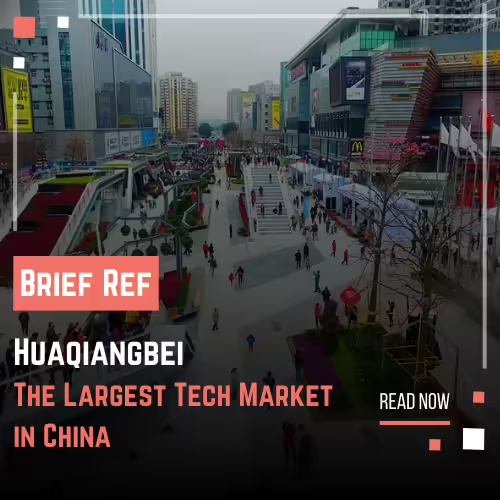
The Largest Tech Market in China
When one thinks of the global hubs for electronics and technology, Huaqiangbei in Shenzhen, China, instantly comes to mind. Huaqiangbei is widely regarded as the world’s largest electronics market, with its sprawling streets filled with vendors selling everything from basic electronic components to the latest smartphones and gadgets. This bustling marketplace is not only a significant player in China’s tech industry but also a critical part of the global supply chain for electronic goods.
The Origins of Huaqiangbei
Located in the Futian District of Shenzhen, Huaqiangbei’s rise is closely tied to the transformation of Shenzhen from a small fishing village into a major metropolis. Shenzhen was designated a Special Economic Zone (SEZ) in 1980 by Deng Xiaoping, marking the beginning of China’s economic reform and opening-up policies. This designation allowed Shenzhen to attract foreign investment, particularly in manufacturing and electronics. Over the next few decades, the city grew rapidly, with Huaqiangbei emerging as a central hub for technology manufacturing and trade.
In the early 1990s, the region that is now Huaqiangbei was largely undeveloped. It was initially known as a center for raw materials and electronic components due to its proximity to numerous factories in the area. Over time, Huaqiangbei became a focal point for the electronics industry, as traders and manufacturers converged to exchange products and materials. With Shenzhen’s burgeoning role in global electronics production, Huaqiangbei evolved from a niche market for electronic parts into a massive marketplace offering a wide range of tech goods.
The Growth of Huaqiangbei as a Global Tech Hub
Huaqiangbei’s explosive growth paralleled Shenzhen’s rise as a global center for electronics manufacturing. By the 2000s, Huaqiangbei had become synonymous with innovation, entrepreneurship, and commerce. The marketplace grew vertically, with multi-story buildings like the SEG Electronics Market and Huaqiang Electronic World housing hundreds of small stalls and shops selling every imaginable electronic component.

One of the key reasons for Huaqiangbei’s rapid growth is its unique supply chain ecosystem. Shenzhen’s proximity to the Pearl River Delta, where many of the world’s electronics manufacturers are based, allowed Huaqiangbei to become the go-to market for both raw components and finished products. Manufacturers could source all the materials they needed locally, driving down costs and speeding up production. Huaqiangbei quickly became known as the place to source everything from individual electronic chips to fully assembled gadgets.
By the mid-2000s, Huaqiangbei was already being referred to as the “Silicon Valley of Hardware.” Entrepreneurs and engineers from around the world came to Shenzhen to prototype and produce their designs. The market became a focal point for innovators who wanted to bypass traditional supply chains and directly engage with manufacturers and parts suppliers
The Importance of Huaqiangbei Today
Today, Huaqiangbei is not just a marketplace, it is a symbol of China’s dominance in the global tech industry. The market spans several city blocks, with its stores selling a dizzying array of products, including:
- Smartphones and mobile accessories
- Drones and robotics
- Smart home devices
- Wearable technology
- Cameras, computers, and gaming consoles
- DIY electronics and prototyping kits
In addition to finished products, Huaqiangbei is also a treasure trove for makers, hobbyists, and engineers. Many stalls sell individual components like resistors, capacitors, transistors, and microchips, catering to those building custom electronics. This accessibility to parts has cemented Huaqiangbei as the heart of the global maker movement. Engineers and DIY enthusiasts from around the world flock to the market to find components unavailable elsewhere or at prices that are unbeatable.
The Role of E-commerce and Global Reach
While Huaqiangbei remains a physical marketplace, its reach has extended globally thanks to e-commerce platforms. Many of the vendors in Huaqiangbei now sell their products on platforms like Alibaba, AliExpress, and Taobao, making it possible for people around the world to access Huaqiangbei’s vast inventory of electronics. This expansion has made Huaqiangbei a critical part of the global supply chain, particularly for small and medium-sized businesses that rely on the affordable prices and wide selection of goods available in the market.
The market’s influence has grown beyond China’s borders, as many international tech companies now source components directly from Huaqiangbei or work with local suppliers to manufacture their products. Startups and tech giants alike use the market as a launching pad for innovation, given the speed with which prototypes can be turned into products.
Challenges and Future Prospects
Despite its success, Huaqiangbei faces several challenges. The rise of intellectual property concerns, counterfeit goods, and copycat products has cast a shadow over the market’s reputation. Some vendors have been accused of selling fake or low-quality products, which has made buyers more cautious. However, many reputable vendors operate within Huaqiangbei, and efforts are being made to curb counterfeit sales.
Another challenge is the growing importance of online retail. With the rise of global e-commerce giants, fewer people are visiting physical markets like Huaqiangbei in person, opting instead to purchase components and electronics online. To stay competitive, many Huaqiangbei vendors have adopted hybrid business models, offering both in-person and online services.
Despite these challenges, Huaqiangbei’s future remains bright. It continues to be a center for innovation, entrepreneurship, and global commerce. As China’s tech industry continues to grow, Huaqiangbei is likely to remain a key player in the global supply chain, adapting to new trends and technologies while maintaining its status as the world’s largest electronics market
Brief
Huaqiangbei’s transformation from a raw materials market to the world’s largest electronics hub mirrors the rise of Shenzhen as a global manufacturing powerhouse. With its unique blend of innovation, commerce, and supply chain efficiency, Huaqiangbei has become an indispensable part of both China’s and the world’s tech industries. Its continued evolution in the face of challenges will determine how it maintains its status as a beacon of technological progress.



